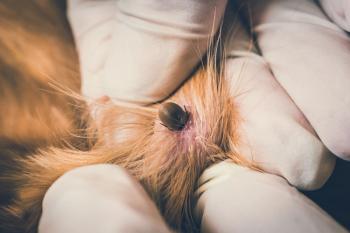
Treating the mange mite in alpacas and llamas
An overview on managing and treating dermatological conditions including sarcoptic mange in camelids.
Camelids originate from South America where humans domesticated them approximately 6,000 years ago. The Spanish conquest in 1532 is responsible for the loss of 90% of all camelids in South America. Many native people perished, and the knowledge of how to raise camelids vanished with them. In the United States, we have roughly 425,000 registered llamas and alpacas, primarily for wool production and protection of other livestock but also as pets.1
Farmers monitor camelids for common dermatological problems such as sarcoptic mange. Sarcoptic mange is an extremely contagious skin condition caused by parasitic mites. Symptoms include pruritis, alopecia, and hyperkeratosis or thickening of the outer layer of the skin. Although many medications are available to treat mange, the treatment regimens are challenging due to their lack of efficiency, poor absorption, and the long length of time required for treatment. Researchers from Italy and Romania developed a case report that examined an alpaca and two llamas with sarcoptic mange and described the successful treatment of Sarcoptes mites with various medications.1
An alpaca from a Romanian zoo, Bonnie, was treated with subcutaneous ivermectin annually as part of the zoo’s parasite control program. Upon clinical examination, Bonnie had skin lesions on the ears, pruritis, alopecia, hyperkeratosis, and exhibit restlessness. She was treated with subcutaneous doramectin with no improvement in her condition. (The avermectin class [doramectin, eprinomectin, ivermectin] is preferred for mange.) After 2 months, the zoo transferred Bonnie to the Department of Parasitology and Parasitic Disease in Romania. There she was treated with an oral multivitamin/mineral complex, local salicylic acid mixed with glycerol, chlorhexidine 3% shampoo, local amitraz diluted in water, and subcutaneous eprinomectin. These medications were used to aid recovery, remove the hyperkeratotic crusts, clean the ear pinas, and eradicate the sarcoptic mange mite infestation. Her shelter underwent a weekly cleansing protocol. Staff collected skin scrapings weekly until negative for 2 months. Bonnie returned to the zoo after a complete recovery.1
Two llamas from a recreational teaching farm, Pacha and Cuzco, experienced intense itching, diffuse scaling, alopecia, and reddening of the distal hindlimbs. A large animal practitioner administered ivermectin subcutaneously for suspected mange. Multiple doses of ivermectin failed to improve the symptoms and the farm owners requested a second opinion from the Parasitology Unit of the Department of Veterinary Sciences. After confirming sarcoptic mange mites, they administered five doses of subcutaneous moxidectin as part of a new treatment plan. After treatment, no clinical signs were detected, and negative mite scrapings were recorded for both animals.1
In another study2, veterinarians euthanized 3 alpacas after they failed to respond to 4 different medications. Veterinarians must be aware of medications that can successfully treat sarcoptic mange. Reliable treatment is necessary because the skin lesions and self-trauma induced by pruritus can make the infected animals susceptible to secondary bacterial infections. More research should be done to develop specific products available to treat sarcoptic mange and to form effective treatment regimens.
Reference
- Deak G, Moroni B, Boncea AM, Rambozzi L, Rossi L, Mihalca AD. Case report: Successful treatment of Sarcoptic mange in European camelids. Front. Vet. Sci. 2021; 8:742543. doi: 10.3389/fvets.2021.742543
- Borgsteede FH, Timmerman A, Harmsen MM. A case of very serious Sarcoptes mange in alpacas (Lama pacos). Tijdschr Diergeneeskd. 2006; 131(8):282–283.
Newsletter
From exam room tips to practice management insights, get trusted veterinary news delivered straight to your inbox—subscribe to dvm360.




